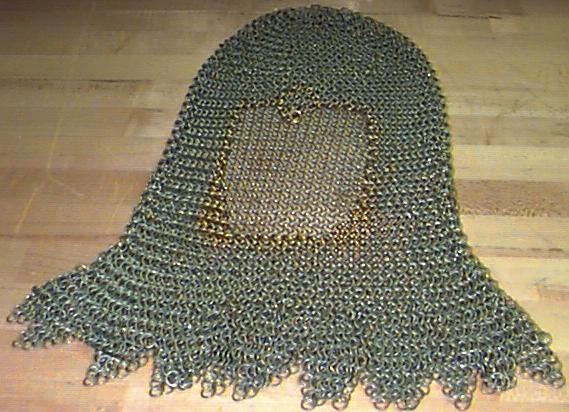The Headband should always be constructed first. That way you know exactly how big both the cap and faceplate should be made. Make a band of links three rows wide and long enough to just go around you head above your eyebrows. Note that the bottom of the headband will be the top of the opening for the face. Also note exactly how many links are in each row of the band, this is the number of links that should be in the last row of the cap.
To begin the cap start with a single ring of the size you wish to use (in this case I'll give an example using 5/16" 16 awg links). Connect 10 rings to this single ring. This can be considered to be a single row of 10 links. Connect a second row of ten links to this first row by connecting a single link to the two above it (in the usual fashion). The third row will be the first expansion row. Connect ten links in the usual fashion to the second row and then add a diverging link for every two normal links (diverging links are shown in red). So the third row has 15 links. The fourth row should be a non-expanding row of 15 links. The fifth row (not shown) should expand one diverging link for each three normal (making 20 total). Each subsequent row should (in general) alternate diverging and non-diverging rows. I have not given specific measurements for this part because everybody has a different shaped head. You should try on the cap after each row to make sure that you are not expanding too fast or too slow. Once you have expanded your cap so that it has the same number of rings as your head band (this may take some planning ahead) you can attach the two together with a non-expanding row.
Now you should make a sheet of maille that fits around your head and leaves enough room for your face. In my example this was the number of links in my headband minus 17. Make the sheet long enough to go down to your lower neck and then attach it to your headband. You now have a basic coif. To make it a full coif you will need to attach a Bishop's Mantle to the bottom of your faceplate. the number of links in the first five rows of your bishop's mantle does not need to be the same as in your headband, just as long as it fits comfortably over your head. Some people have designed chin straps to hold a coif firmly in place on the head, but I have found that a properly fit full coif does not need one. Here is a completed coif with brass trim along the face.

Of all the chainmaille designs I have seen, the coif leaves the most to experimentation. You need to be constantly making adjustment to your design as you create your coif, but the end result will be most satisfying. Good luck!